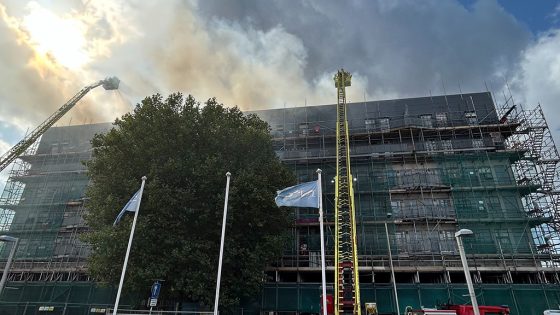Monday’s fire at a residential block in Dagenham may have started from flammable building materials stored on scaffolding, according to early investigations highlighted by the Institution of Fire Engineers (IfE).
The Health and Safety Executive (HSE) yesterday announced it had started investigating whether cladding-remediation works were a factor in the Spectrum Building blaze.
And in a blog post yesterday, the IfE added its voice to the experts raising fears that scaffolding erected around t, as part of those works played a role in the spread of the blaze.
The IfE post says: “According to preliminary investigations, the fire may have started from building materials kept on the scaffolding, which accelerated the spread due to the materials’ flammability and the scaffolding’s open, vertical structure, which can operate as a chimney.”
It adds: “The Dagenham fire demonstrated how these risks could come together to create a rapidly escalating fire that threatens both the building under construction and adjacent properties.”
The IfE comments came after Construction News earlier this week quoted an independent fire consultant who raised concerns about the role of scaffolding in the fire. At that point, the consultant speculated that the source could have been within a ground-floor residential flat.
According to the IfE, scaffolding often features combustible wooden planks and plastic sheeting that can quickly catch fire, as well as temporary wiring that may ignite if not properly safeguarded.
The fire-safety body added that scaffolding’s structure can also present risks if it collapses in high heat, blocks escape routes or acts as a chimney, funnelling flames up a building.
Fire-safety expert Arnold Tarling, who raised the alarm about dangerous cladding in the years leading up to the Grenfell Tower blaze of 2017, told Construction News that it was “highly likely” the fire was spread by scaffold boards.
Tarling visited the Dagenham site the day after the fire and noticed that cladding remained on the upper two stories, where non-compliant cladding had originally been identified, while the timber-framed structures behind had burnt down.
He said: “The cladding has failed in areas, but I can’t see it having spread in the cladding. In my opinion, the spread of the fire was the scaffold, not the cladding.
“At each level there were wooden boards. Had the wooden boards not been there, the fire wouldn’t have spread so quickly upwards or downwards.”
A senior manager at contractor Fleetwood Architectural Aluminium, which was contracted to deliver the remedial works, declined to comment on the IfE blog when contacted by Construction News.
Inspectors from the HSE’s investigations and building-safety divisions visited the site yesterday (29 August).
The regulator will investigate how the cladding-remediation works were organised and whether the main person accountable for the building under new building-safety laws still had a duty to prevent fire spread at the time of the blaze.
The HSE said it would work closely with the London Fire Brigade (LFB), the police and the local authority during its probe.
The IfE is a key member of building-safety monitor CROSS, which investigated the fire risk of scaffolding on an occupied building in a 2023 report.
IfE technical director Paul Trew told CN: “In a matter of days before the release of the Grenfell Phase 2 report, this is another incident that highlights the need for more stringent safety protocols within high-rise buildings.”
Yesterday, representatives of the Building Safety Regulator attended a roundtable called by housing secretary Angela Rayner, where she and building-safety minister Rushanara Ali called upon those present to speed up building remediation.
Rayner emphasised to representatives from the LFB, National Fire Chiefs Council, Local Government Association and multiple regional mayors the importance of ensuring people are safe in buildings undergoing remediation.
She said speeding up building remediation is “absolutely critical”, adding: “Seven years on from Grenfell, action has been far too slow and the fire in Dagenham is a horrific reminder of the risk unsafe cladding still poses to far too many people.”
Ali said: “It is absolutely essential that central and local government, regulators and partners come together, as we have today, to drive fast and effective change to get buildings fixed, made safe, and make sure residents are protected.”
The HSE added that it was working with the LFB to determine the facts about a separate fire earlier this week at a high-rise in Blackwall, east London.

